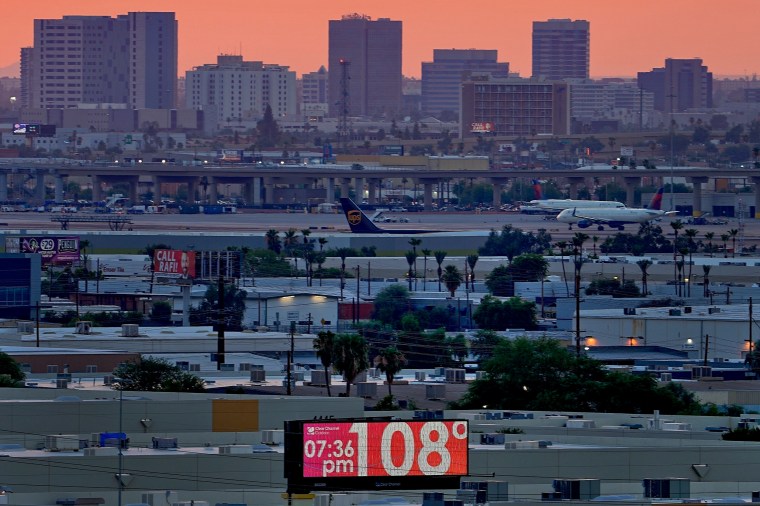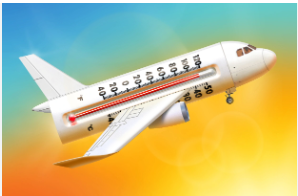The aviation industry is expanding runway space for flights, restricting pets in cargo, and “taking steps” to stop hot drink from blowing up as a result of rising temperatures brought on by climate change.
Another summer of record-breaking heat waves and record-breaking air travel has occurred. Airline companies and airports claim they can manage both.

According to projections made by the trade association Airlines for America, U.S. airlines anticipate carrying 271 million passengers globally this summer, an increase of 6.3% from the previous season. To handle the increase, carriers have added more flights and seats, sometimes too many. It coincides with a year in which June was the warmest on record for the Earth, with two days in a row breaking records for global temperatures last week.
Nevertheless, according to Kevin Burke, president and CEO of Airports Council International–North America, the aviation sector is acclimating to “a new normal” of sweltering temperatures throughout the peak summer travel season. According to him, airports have so far been able to “adapt to these conditions” by collaborating with airlines to address operational and safety concerns.
The “extreme weather” delays brought on by hurricanes, blizzards, and tornadoes are tracked by the U.S. Department of Transportation, while delays brought on by heat waves are not. Furthermore, although the percentage of weather-related delay minutes has decreased over the past few decades, heat-related issues have been more noticeable recently.
Flights at London’s Luton Airport were temporarily suspended in July 2022 due to runway damage caused by an intense heat wave that swept throughout Europe. Due to unprecedented heat that caused tarmac temperatures to reach 130 degrees Fahrenheit in Seattle and Portland and disrupted operations in California, Texas, Arizona, and Louisiana, Alaska Airlines had to cancel and postpone flights in June of the previous year. Ground personnel were provided with air-conditioned “cool down vans” for breaks.
The bigger, heavier planes used for long-haul flights may find it more difficult to take off in Las Vegas, where temperatures are once again breaking records this summer, according to officials at Harry Reid International Airport (LAS).
It’s physics: according to pilot Patrick Smith, the creator of the aviation site “Ask the Pilot,” “Airplanes perform better aerodynamically at cool temperatures, when the air is denser.” Excessive heat diminishes the power produced by airplane engines, necessitating longer runways in order to initiate takeoff and increase altitude.
A representative for LAS, Amanda Mazzagatti, said that in order to overcome this difficulty in Vegas, “the air traffic control tower will institute a configuration change for takeoffs to the east, which avoids the mountainous terrain.” Because it lowers the frequency of takeoffs per hour, “that configuration can cause slight delays for departures,” the spokesperson stated.
According to Robert Thomas, an assistant professor at Embry-Riddle Aeronautical University in Daytona Beach, Florida, high temperatures can force airplanes to lower their weight before taking to the air by dropping cargo, fuel, or even passengers. He acknowledged that making these changes prior to flight “may also cause delays and anger passengers.”
According to a pilot’s latest TikTok explanation, planes will occasionally burn off fuel on the runway to save weight on days when temperatures increase more than anticipated. However, they can only burn so much before there isn’t enough left to reach the goal.
According to Smith, excessive heat might cause mechanical problems. Additionally, engines have internal temperature restrictions that must not be exceeded in order for function to continue. These limits are particularly easy to breach in extremely hot weather. As climate change contributes to an increase in extreme weather events, such as heat waves, I anticipate that it will occur more frequently.
However, authorities at Sky Harbor International Airport (PHX) in Phoenix, where temperatures have risen well into the 110s this month, maintain that their facility is “well-prepared for Arizona summers,” with runways designed to handle takeoffs and landings in extreme heat.
A spokeswoman for the airport, John Trierweiler, stated that preparations for warm weather start every April. Employees in the aviation department are required to complete a heat-safety training, and this year, PHX provided a film on the topic for all airport workers, he noted. The airport advises staff to drink plenty of water, take regular breaks, and, if they’re working outside, come inside every hour to cool off during periods of high heat.
He said, “To stay hydrated in the Arizona heat, passengers are also encouraged to use the airport’s water stations.”

According to spokesman Chris Perry, Southwest Airlines claims to have everything under control even if extreme heat is “arriving earlier and persisting throughout the summer” at Sun Belt airports where the airline has a significant presence. Southwest, like other airlines, runs air conditioning on the ground and requests that passengers lower window shades and open overhead air vents as soon as they arrive in order to keep their aircraft cool.
According to spokeswoman Drake Castañeda, travelers are also requested to take these actions by Atlanta-based Delta Air Lines. Employees are allowed to stop boarding when a cabin becomes uncomfortable hot and wait for it to cool down, even if it causes a delay, he added.
Perry confirmed tales of drink cans popping owing to high temperatures, but said Southwest hasn’t recently seen any large delays or cancellations due to heat.
He stated, “We are aware of the problem and have been taking action to keep beverages onboard colder.”
According to Burke of ACI-NA, high temperatures are also forcing airports and airlines to modify their ground operations and modernize their infrastructure. A few airports are upgrading their electrical power systems, replacing outdated central plant equipment with more energy-efficient models, and adding “smart glass” to lessen solar heat transmission into terminals.
Pets are a concern for carriers as well. Pets are not permitted to fly in cargo holds on United, Delta, or Southwest Airlines at any time of year. Although there are seasonal limits, Alaska and America do.
In Alaska, where breed restrictions for short-nosed dogs and cats apply year-round, pets are permitted to travel only when the temperature in the cities of departure and arrival is between 45 and 85 degrees. The airline will not allow dogs in the luggage compartment on flights arriving or leaving between 10 a.m. and 9 p.m. at over two dozen airports for the most of this summer.
Additionally, American Airlines prohibits pets as cargo in all weather conditions above 85 degrees and has breed restrictions in place year-round. Pets are not allowed in cargo on flights that originate, connect, or terminate in Phoenix, Tucson, Arizona; Las Vegas; or Palm Springs, California, from May 1 through September 30.
Customers are informed by the carrier that “we will take your pet to a local kenneling facility — at no charge — for a comfort stop to play, eat, and sleep until temperatures return to a safe range if we find that temperatures become unsafe during travel.”






